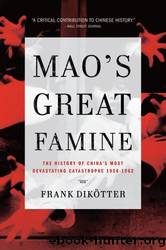Mao's Great Famine: The History of China's Most Devastating Catastrophe, 1958-1962 by Frank Dikötter

Author:Frank Dikötter
Language: eng
Format: mobi
Tags: History, China, Asia, General
ISBN: 9780802779236
Publisher: Walker
Published: 2011-10-11T00:00:00+00:00
One of the many paradoxes of the planned economy, therefore, was that everybody traded. People speculated by buying in bulk, betting on the fact that shortages and inflation would push the price up. An entire operation was run by Hubei University, with telegrams instructing agents to buy or sell specific commodities according to the fluctuating demands of the black market. A research centre at the Chinese Academy of Social Science in Shanghai employed twenty students from East China Normal University to buy goods which were traded for scarce commodities with other units.21
Party members were well placed to undertake speculative operations, some of them on a full-time basis. Li Ke, a cadre from the Jianguomen commune to the east of Beijing, wrote himself a certificate for sick leave for nine months and started trading in sewing machines, bicycles and radios, investing the profit in a bulk acquisition of electric bulbs and cables. These he sold in Tianjin, purchasing in turn furniture which he unloaded in the suburbs precisely when the market contracted: he thus acted in a commercially astute way, all the while being in the pay of the state. Many others did the same.22
But most cadres had bigger fish to fry, and petty trade was left to ordinary people. In Shanghai, a once freewheeling treaty port, trading habits died hard. Zhao Jianguo, a woman entrepreneur with little money, dealt mainly in small commodities such as light bulbs, but she also made a good profit on a prestigious Phoenix bicycle. Li Chuanying, also a petty trader, bought goods in Shanghai and sold them in Anhui province. Hu Yumei travelled to Huangyan, Zhejiang, to deal in straw hats, mats, dried fish and shrimps, often doubling her money. Ma Guiyou made about 100 yuan a month buying up jewellery and watches from wealthy families downtown and dealing in ration tickets in the countryside: ‘I am not a counter-revolutionary! I don’t steal and I don’t rob, and I don’t have a job, so who cares if I do a bit of business?’ The officials who compiled the report with the help of neighbourhood committees in August 1961 were taken aback not only by the range of goods on offer, but also by the quality of information about market conditions. Despite all the economic information gathered by the machinery of the central planners, petty traders were more in touch with popular demand than the party. The phenomenon was widespread, drawing participants from all social backgrounds, ranging from old rickshaw puller Chen Zhangwu, who sold fruit from the countryside to make ends meet, to influential managers who used official trips to distant places such as Inner Mongolia and Manchuria as a cover for private deals.23
Factory workers also traded goods. The Federation of Trade Unions was alarmed by workers keen to pursue a ‘capitalist lifestyle’ by spurning the principles of the planned economy and speculating on scarce commodities, carefully comparing prices in different shops and buying for profit. Some would join a queue wherever they spotted one, regardless of what was being sold.
Download
This site does not store any files on its server. We only index and link to content provided by other sites. Please contact the content providers to delete copyright contents if any and email us, we'll remove relevant links or contents immediately.
| Africa | Americas |
| Arctic & Antarctica | Asia |
| Australia & Oceania | Europe |
| Middle East | Russia |
| United States | World |
| Ancient Civilizations | Military |
| Historical Study & Educational Resources |
Wabi sabi by Kempton Beth(721)
Mr. Selden's Map of China by Timothy Brook(601)
Heroic Hindu Resistance To Muslim Invaders (636 AD to 1206 AD) by Sita Ram Goel(573)
Akbar: The Great Mughal by Ira Mukhoty(544)
The Meaning of India by Raja Rao(537)
Vedic Physics: Scientific Origin of Hinduism by Raja Ram Mohan Roy(535)
Banaras by Diana L. Eck(526)
Philippines--Culture Smart! by Culture Smart!(503)
Mao's Great Famine: The History of China's Most Devastating Catastrophe, 1958-1962 by Frank Dikötter(500)
Food of India by unknow(497)
China Unbound by Joanna Chiu(486)
How to Be a Modern Samurai by Antony Cummins(474)
India--Culture Smart! by Becky Stephen(473)
A History of Japan by R.H.P. Mason & J.G. Caiger(468)
Insurgency and Counterinsurgency by Jeremy Black(465)
North of South by Shiva Naipaul(462)
The Genius of China: 3,000 Years of Science, Discovery, and Invention by Robert Temple(446)
Kim Jong Un and the Bomb by Ankit Panda(431)
The Digital Silk Road by Jonathan E. Hillman(423)
